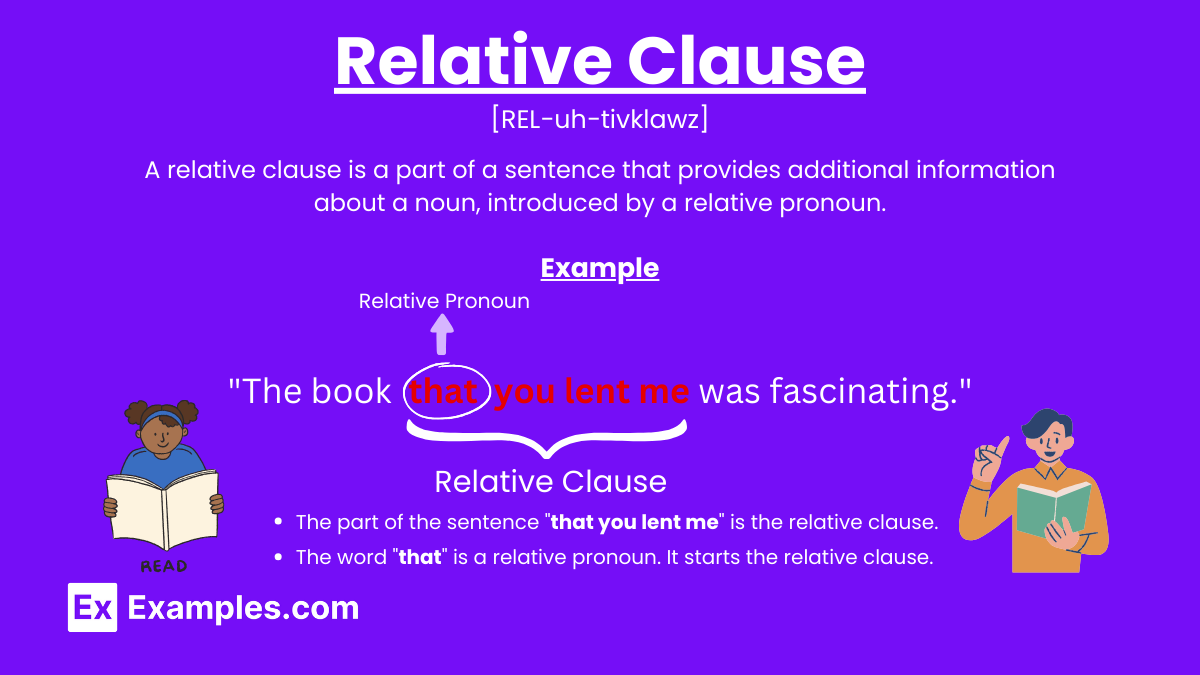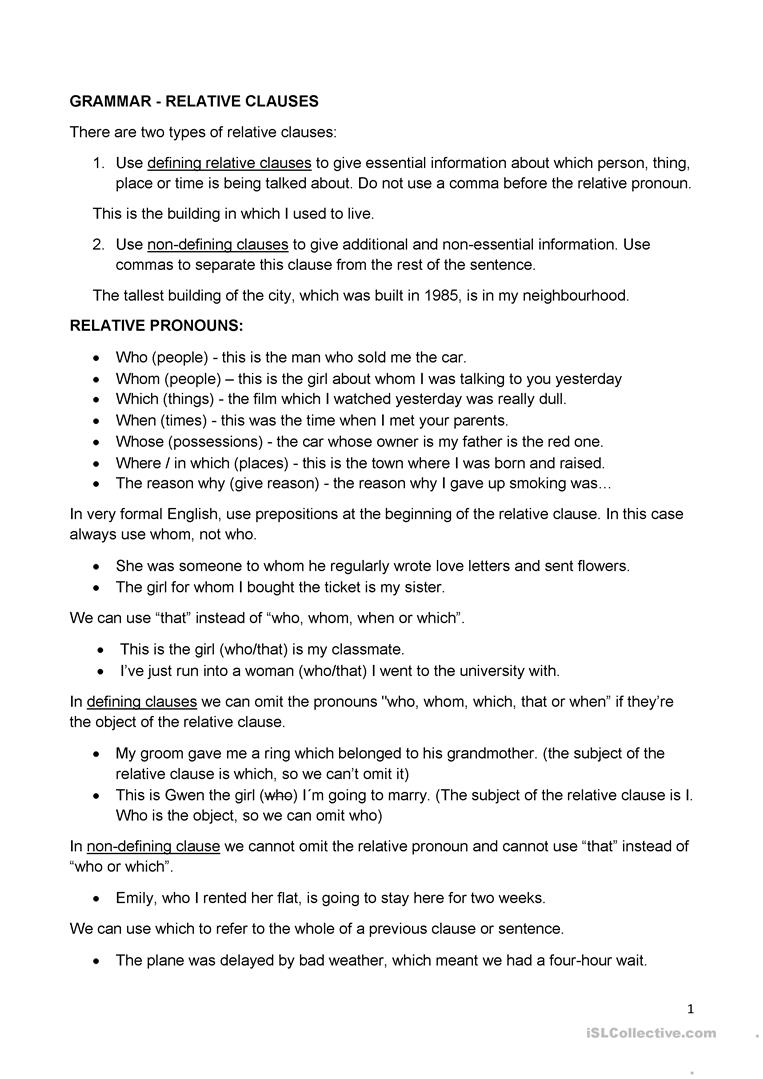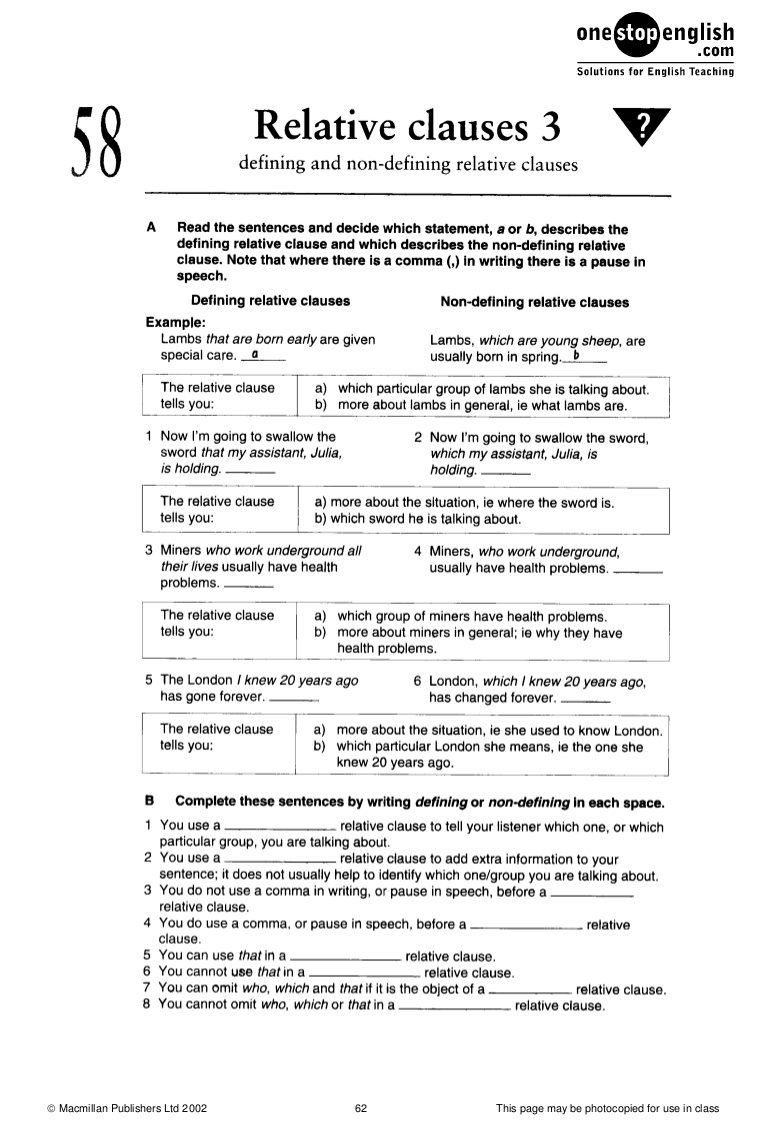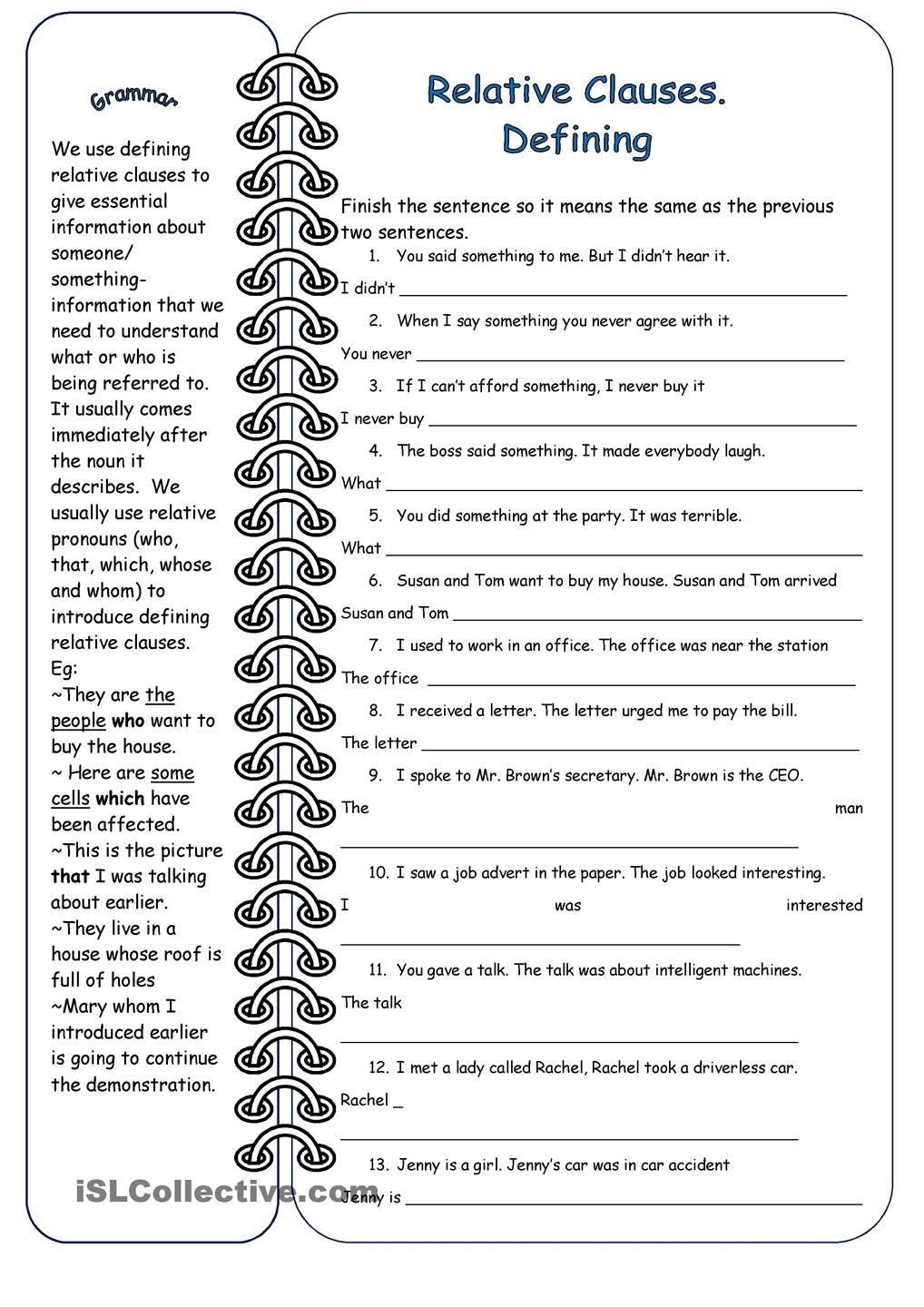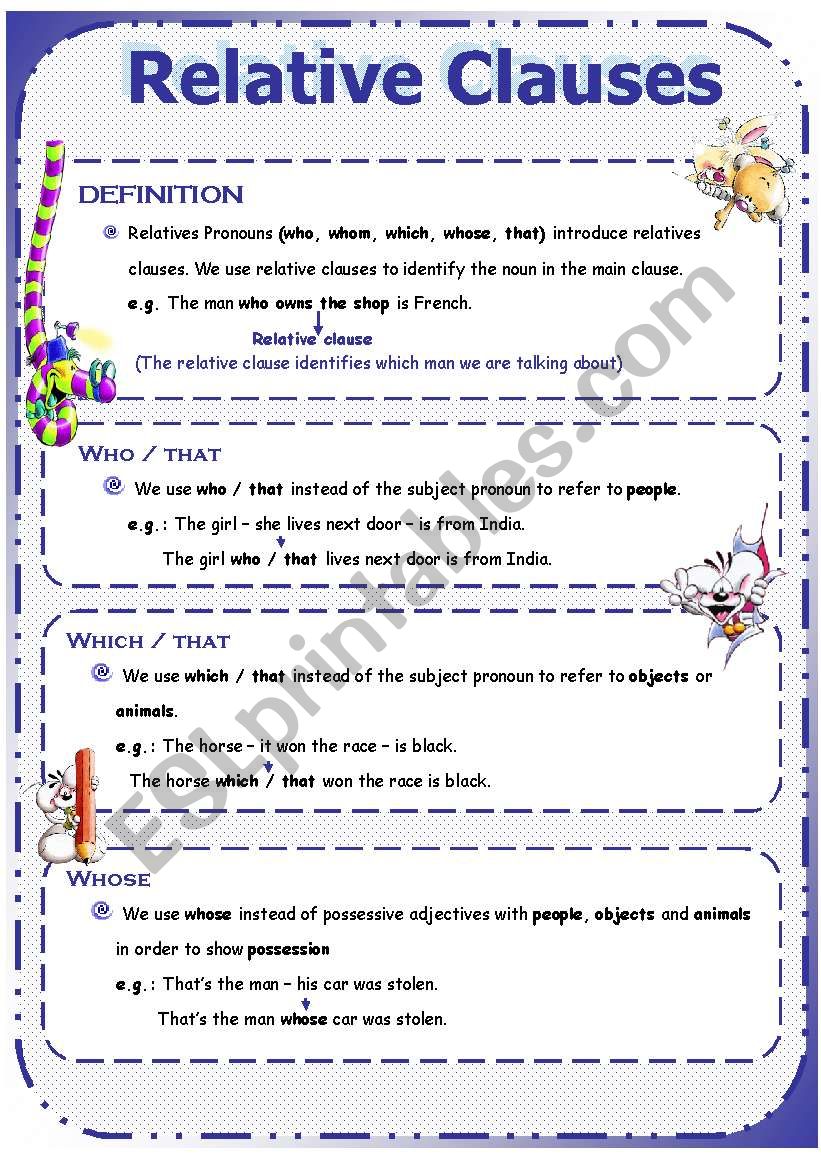35+ Relative Clause Examples
Anyone who’s interested in learning the fundamentals of the English language knows how complex the underlying concept of grammar and sentence structure can be.
- What Is an Example of a Dependent Clause?
- Complete and Incomplete Sentences — Definition and Examples
Words aren’t just a group of letters joined together, but they serve as a primary element in developing a sentence. We use words to form sentences, sentences to compose paragraphs, and paragraphs to construct essay writing. But between the simple sentences and complex sentences that constitute our paragraphs, comes a group of related words containing a subject and a predicate or verb: clauses.
What Is a Relative Clause?
A relative clause is a dependent clause used to provide additional information in a sentence by defining the noun given. This may also be referred to as an adjective clause, an adjectival clause, or a relative construction. This usually adapts, describes, or modifies a noun or a noun phrase, and is introduced by a relative pronoun (that, which, who, whom, whose) or a relative adverb (why, when, where). You may also see subordinate clause examples.
Types of Relative Clauses
1. Defining (Restrictive) Relative Clauses
Provide essential information about the noun they modify. They define or restrict the noun’s meaning.
- Example: “The book that you lent me was fascinating.”
2. Non-Defining (Non-Restrictive) Relative Clauses
Provide extra information about the noun they modify. The sentence would still be clear without this information.
- Example: “My brother, who lives in New York, is visiting us.”
3. Restrictive Relative Clauses
Similar to defining clauses, they are necessary to understand the noun’s identity.
- Example: “The students who study hard usually get good grades.”
4. Non-Restrictive Relative Clauses
Similar to non-defining clauses, they add extra, non-essential information.
- Example: “Paris, which is the capital of France, is a beautiful city.”
5. Relative Clauses with “That”
Used primarily in defining clauses, “that” can replace “who,” “whom,” or “which.”
- Example: “She is the artist that painted this mural.”
6. Relative Clauses with “Who” or “Whom”
“Who” is used for people as the subject, and “whom” is used for people as the object.
- Example:
- “The person who called you is my friend.”
- “The person whom you called is my friend.”
7. Relative Clauses with “Which”
Used for animals and things in both defining and non-defining clauses.
- Example: “The car which broke down is new.”
Relative Clause Examples Sentences
Defining (Restrictive) Relative Clauses
- “The book that you lent me was fascinating.”
- “Students who study hard usually get good grades.”
- “The cake that she baked was delicious.”
- “The man whom we met is a famous author.”
- “The house where they live is very old.”
Non-Defining (Non-Restrictive) Relative Clauses
- “My brother, who lives in New York, is visiting us.”
- “Paris, which is the capital of France, is a beautiful city.”
- “My car, which I bought last year, is already broken.”
- “Mrs. Smith, who is my neighbor, bakes wonderful cookies.”
- “The conference, which I attended last month, was very informative.”
Relative Clauses with “That”
- “She is the artist that painted this mural.”
- “The cake that he baked was delicious.”
- “The dog that barked all night is very annoying.”
- “The car that broke down was brand new.”
- “The house that they bought needs a lot of repairs.”
Relative Clauses with “Who” or “Whom”
- “The person who called you is my friend.”
- “The woman who lives next door is a doctor.”
- “The student who won the award is very talented.”
- “The teacher whom you mentioned is retiring next year.”
- “The musician who played the piano was amazing.”
Relative Clauses with “Which”
- “The car which broke down is new.”
- “The movie which we watched was thrilling.”
- “The house which they sold had been in the family for generations.”
- “The book which she recommended was very interesting.”
- “The project which he completed was highly praised.”
Relative Clauses with “Where”
- “The house where I grew up is now a museum.”
- “This is the park where we used to play.”
- “The restaurant where we had dinner was excellent.”
- “The city where she was born is very beautiful.”
- “The school where he teaches is very prestigious.”
Relative Clauses with “When”
- “I remember the day when we first met.”
- “1999 was the year when I graduated.”
- “There are times when I feel very tired.”
- “That was the moment when everything changed.”
- “Summer is the season when we usually go on vacation.”
More Examples and Worksheets For Relative Clause:
Defining and Non-Defining Relative Clause Example
Free Relative Clause Worksheet Example
Printable Relative Clause Worksheet Example
Relative Clause Exercise Example
Relative Clause Sample Worksheet
Relative Clause Worksheet Example
Simple Relative Clause Worksheet Example
Teaching Relative Clauses Example
Relative Clause Usage

Relative clauses add extra information about a noun in a sentence, enhancing the meaning and providing additional details. Here’s how to use them:
1. Defining (Restrictive) Relative Clauses
These clauses provide essential information about the noun they modify. They are crucial for understanding which specific person or thing we are talking about.
- Example: “The book that you lent me was fascinating.”
- Usage: Without the relative clause, the sentence would be unclear because it wouldn’t specify which book is being referred to.
2. Non-Defining (Non-Restrictive) Relative Clauses
These clauses add extra information about the noun, which is not necessary for identifying it. They are usually separated by commas.
- Example: “My brother, who lives in New York, is visiting us.”
- Usage: The main information is that the brother is visiting. The fact that he lives in New York is additional information.
3. Relative Clauses with “That”
Used primarily in defining clauses, “that” can replace “who,” “whom,” or “which.”
- Example: “The cake that he baked was delicious.”
- Usage: It specifies which cake is being talked about, making the sentence clear and specific.
4. Relative Clauses with “Who” or “Whom”
“Who” is used for people as the subject, and “whom” is used for people as the object.
- Example: “The person who called you is my friend.”
- Usage: It tells us which person is being referred to.
5. Relative Clauses with “Which”
Used for animals and things in both defining and non-defining clauses.
- Example: “The car which broke down is new.”
- Usage: It provides information about which car is being discussed.
6. Relative Clauses with “Where”
Refers to a place.
- Example: “The house where I grew up is now a museum.”
- Usage: It specifies the house being referred to by indicating its significance.
7. Relative Clauses with “When”
Refers to a time.
- Example: “I remember the day when we first met.”
- Usage: It provides a specific time frame, adding context to the sentence.
Characteristics of a Relative Clause
Relative clauses are used to add more information to a sentence, providing additional details about a noun. Here are the key characteristics of relative clauses:
1. Introduced by Relative Pronouns
Relative pronouns include who, whom, whose, which, and that. These pronouns link the relative clause to the noun it describes.
- Example: “The book that you lent me was fascinating.”
2. Provides Additional Information
Relative clauses give more details about the noun, making the meaning clearer and more specific.
- Example: “My friend, who is a doctor, is visiting.”
3. Types: Defining and Non-Defining
Defining (Restrictive) Relative Clauses: Essential for understanding the noun. No commas.
- Example: “The student who studies hard will succeed.”
- Non-Defining (Non-Restrictive) Relative Clauses: Provide extra information. Use commas.
- Example: “Paris, which is the capital of France, is beautiful.”
4. Embedded in Sentences
Relative clauses are embedded within sentences and cannot stand alone.
- Example: “The car which he bought is very expensive.”
5. Can Replace Nouns or Pronouns
The noun or pronoun being described can be replaced by the relative pronoun within the clause.
- Example: “She is the person who called you.”
6. Refers to People, Things, Places, Times, and Possessions
Different relative pronouns are used based on the noun being referred to:
- Who/Whom: People
- Which: Things and animals
- That: People, things, and animals (primarily in defining clauses)
- Whose: Possessions
- Where: Places
- When: Times
7. Functions as an Adjective
Relative clauses describe or modify nouns, functioning similarly to adjectives.
- Example: “The house where I grew up is now a museum.”
8. Can Be Subject or Object
The relative pronoun can act as the subject or object of the relative clause.
- Subject Example: “The woman who lives next door is a teacher.”
- Object Example: “The book which I read was fascinating.”
9. Can Be Reduced:
Sometimes, relative clauses can be reduced to shorter phrases.
- Example: “The man driving the car is my uncle.” (Reduced from “The man who is driving the car…”)
Comparison of Defining and Non-Defining Relative Clauses
| Aspect | Defining (Restrictive) Relative Clauses | Non-Defining (Non-Restrictive) Relative Clauses |
|---|---|---|
| Purpose | Provide essential information about the noun to define it precisely. | Add extra, non-essential information about the noun. |
| Use of Commas | No commas used. | Commas used to separate the clause from the rest of the sentence. |
| Relative Pronouns Used | That, which, who, whom, whose. | Which, who, whom, whose. |
| Necessity for Sentence Meaning | The sentence meaning changes if the clause is removed. | The sentence remains clear and complete even if the clause is removed. |
| Example 1 | “The book that you lent me was fascinating.” | “My brother, who lives in New York, is visiting us.” |
| Example 2 | “Students who study hard usually get good grades.” | “Paris, which is the capital of France, is a beautiful city.” |
| Example 3 | “The cake that she baked was delicious.” | “My car, which I bought last year, is already broken.” |
| Example 4 | “The man whom we met is a famous author.” | “Mrs. Smith, who is my neighbor, bakes wonderful cookies.” |
| Example 5 | “The house where they live is very old.” | “The conference, which I attended last month, was very informative.” |
| Common Contexts | Necessary details about the subject, often used in everyday explanations, instructions, and definitions. | Additional details about the subject, often used in writing where additional context or descriptive detail is provided, such as in literary works or more formal documents. |
What is a relative clause?
A relative clause is a part of a sentence that provides additional information about a noun, introduced by relative pronouns like who, whom, whose, which, or that.
What are defining relative clauses?
Defining relative clauses give essential information needed to identify the noun. They are crucial for the sentence’s meaning and do not use commas.
What are non-defining relative clauses?
Non-defining relative clauses provide extra information about the noun. They are not essential for understanding the sentence’s main point and are separated by commas.
When do you use “who” in a relative clause?
“Who” is used for people and can act as the subject of the relative clause. Example: “The person who called is my friend.”
When do you use “whom” in a relative clause?
“Whom” is used for people as the object of the relative clause. Example: “The person whom you called is my friend.”
When do you use “which” in a relative clause?
“Which” is used for animals and things in both defining and non-defining clauses. Example: “The book which I read was interesting.”
When do you use “that” in a relative clause?
“That” is used for people, animals, and things in defining clauses only. Example: “The car that broke down is new.”
Can a relative clause be reduced?
Yes, relative clauses can sometimes be reduced by omitting the relative pronoun and verb. Example: “The man driving the car is my uncle.”
What is a relative pronoun?
A relative pronoun introduces a relative clause and links it to the noun it describes. Examples include who, whom, whose, which, and that.
Why are commas used in non-defining relative clauses?
Commas are used to separate non-defining clauses because they add extra, non-essential information. The sentence remains complete without the clause.



